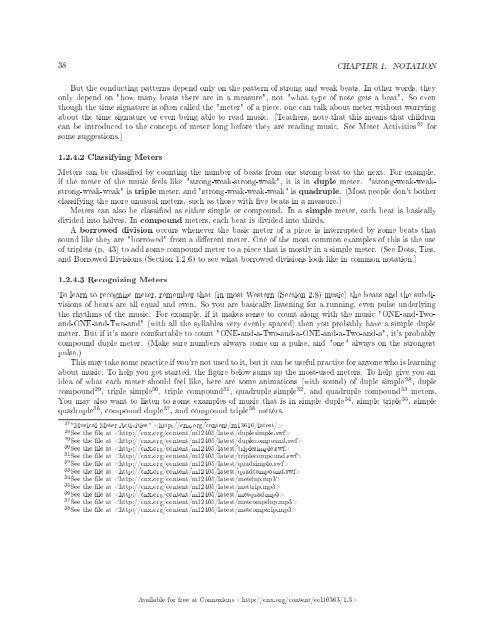Understanding Basic Music Theory, 2013a
Understanding Basic Music Theory, 2013a
Understanding Basic Music Theory, 2013a
You also want an ePaper? Increase the reach of your titles
YUMPU automatically turns print PDFs into web optimized ePapers that Google loves.
38 CHAPTER 1. NOTATION<br />
But the conducting patterns depend only on the pattern of strong and weak beats. In other words, they<br />
only depend on "how many beats there are in a measure", not "what type of note gets a beat". So even<br />
though the time signature is often called the "meter" of a piece, one can talk about meter without worrying<br />
about the time signature or even being able to read music. (Teachers, note that this means that children<br />
can be introduced to the concept of meter long before they are reading music. See Meter Activities 27 for<br />
some suggestions.)<br />
1.2.4.2 Classifying Meters<br />
Meters can be classied by counting the number of beats from one strong beat to the next. For example,<br />
if the meter of the music feels like "strong-weak-strong-weak", it is in duple meter. "strong-weak-weakstrong-weak-weak"<br />
is triple meter, and "strong-weak-weak-weak" is quadruple. (Most people don't bother<br />
classifying the more unusual meters, such as those with ve beats in a measure.)<br />
Meters can also be classied as either simple or compound. In a simple meter, each beat is basically<br />
divided into halves. In compound meters, each beat is divided into thirds.<br />
A borrowed division occurs whenever the basic meter of a piece is interrupted by some beats that<br />
sound like they are "borrowed" from a dierent meter. One of the most common examples of this is the use<br />
of triplets (p. 43) to add some compound meter to a piece that is mostly in a simple meter. (See Dots, Ties,<br />
and Borrowed Divisions (Section 1.2.6) to see what borrowed divisions look like in common notation.)<br />
1.2.4.3 Recognizing Meters<br />
To learn to recognize meter, remember that (in most Western (Section 2.8) music) the beats and the subdivisions<br />
of beats are all equal and even. So you are basically listening for a running, even pulse underlying<br />
the rhythms of the music. For example, if it makes sense to count along with the music "ONE-and-Twoand-ONE-and-Two-and"<br />
(with all the syllables very evenly spaced) then you probably have a simple duple<br />
meter. But if it's more comfortable to count "ONE-and-a-Two-and-a-ONE-and-a-Two-and-a", it's probably<br />
compound duple meter. (Make sure numbers always come on a pulse, and "one" always on the strongest<br />
pulse.)<br />
This may take some practice if you're not used to it, but it can be useful practice for anyone who is learning<br />
about music. To help you get started, the gure below sums up the most-used meters. To help give you an<br />
idea of what each meter should feel like, here are some animations (with sound) of duple simple 28 , duple<br />
compound 29 , triple simple 30 , triple compound 31 , quadruple simple 32 , and quadruple compound 33 meters.<br />
You may also want to listen to some examples of music that is in simple duple 34 , simple triple 35 , simple<br />
quadruple 36 , compound duple 37 , and compound triple 38 meters.<br />
27 "<strong>Music</strong>al Meter Activities" <br />
28 See the le at <br />
29 See the le at <br />
30 See the le at <br />
31 See the le at <br />
32 See the le at <br />
33 See the le at <br />
34 See the le at <br />
35 See the le at <br />
36 See the le at <br />
37 See the le at <br />
38 See the le at <br />
Available for free at Connexions


















